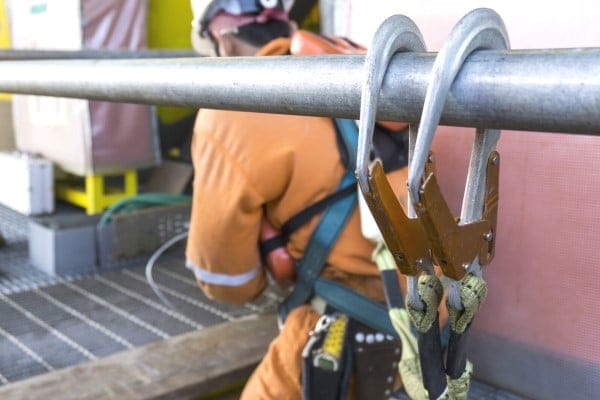Construction Industry Falling Short in Worker Safety
June 29, 2023
By: Nationwide

Substantial demand in nonresidential projects has US construction firms and contractors worried about the availability of workers. Many have resorted to minimizing their hiring standards to fill the labor shortages. But these choices could backfire, leading to disastrous repercussions for the safety of workers in one of the most hazardous industries in America. 1
Despite their preventable nature, falls remain a primary cause of deaths and injuries across the construction industry, resulting in more than 300 deaths each year and thousands of serious injuries. These accidents continue to impact workers' livelihoods as well as business operations, even with expansive efforts in place to educate and enforce safety regulations.
The industry must ramp up focus, education, and training to reduce these hazards—particularly among younger or less experienced workers.
Inexperienced Workers Are More Prone to Falls on Jobsites
Nationwide's claims data indicates construction workers with less than 2 years of experience with a company account for over half (53 percent) of all reported construction fall claims since 2020. Construction businesses have a responsibility to ensure all workers, and especially those new to their company, are adequately trained and equipped with the proper safety gear and knowledge to prevent falls. Protecting the lives of the workforce and ensuring their well-being on the job should be handled with the utmost importance.
The human cost of falls on jobsites is not the only significant financial burden for companies. Nationwide's data reveals that the average workers compensation claim cost in 2022 rose by 15 percent over 2021 across all industries. These increased costs are driven by a variety of factors, including rising healthcare costs and the perilous nature of construction. Further, falls can also negatively impact a company's insurance premiums and reputation.
Labor shortages continue to pressure workers to focus on speed over safety, but ensuring workers make it home to their families at the end of the day is paramount. It's critical that organizations commit to worker safety and instill a program and a work culture that prioritizes fall protection strategies.
Implementing Fall Protection Strategies
To combat fall-related injuries and fatalities, a collaborative effort among all levels of business is essential to implement comprehensive fall protection strategies. These strategies help identify root causes of falls and effectively address these issues moving forward.
Nationwide has developed a fall protection guide to help construction businesses tackle the underlying sources of falls and assist with reducing falls in the workplace. This guide is designed to help businesses develop best practices for fall protection, outline critical roles and responsibilities, and provide guidance on training requirements.
Nationwide's Guide at a Glance: Roles and Responsibilities
Employers have the primary responsibility for handling fall exposures and facilitating appropriate training and procedures. However, a successful fall protection program involves everyone within the organization play a part, which underscores the importance of having clear roles and responsibilities. All workers who could be exposed to potential fall hazards must understand the critical nature of these hazards, understand how to recognize hazards, and know procedures or steps to take to minimize these hazards.
Any successful safety program starts with the ownership's commitment to a safe workplace for all its employees and implementing comprehensive fall protection strategies.
The responsibility of ensuring each employee is provided the required training, ensuring safety policies are consistently enforced, assessing when retraining is needed, fielding suggestions to improve safety, and ensuring proper safety and personal protection gear are available falls on the construction manager.
Supervisors are accountable for enforcing the safety policies, jobsite supervision, training of employees, implementation of safe work practices, and identification and correction of hazardous conditions.
Organizations should have a safety committee whose primary objective is to identify and eliminate hazards. The committee is comprised of representatives from a variety of positions who bring different perspectives on work practices and areas of improvement.
Most importantly, the safety program's ultimate success is dependent on employee involvement and adherence to guidelines, policies, and best practices. All employees are responsible for recognizing and immediately reporting hazards to their supervisors or safety committee, consistently following safe work practices, and using necessary personal protective and fall protection equipment.
Safety Conscious Culture
To avoid falls and mitigate risks of incidents, organizations must emphasize safety through all aspects of their operations. This includes providing clear communication on everyone's roles and responsibilities, supplying workers with proper training and equipment, conducting regular safety inspections, and implementing safety protocols and procedures that adhere to regulatory requirements.
By instilling a culture centralized around worker safety and fall mitigation strategies, we can positively affect change and reduce the number of incidents throughout the industry.
© 2023 Nationwide Mutual Insurance Company
Opinions expressed in Expert Commentary articles are those of the author and are not necessarily held by the author's employer or IRMI. Expert Commentary articles and other IRMI Online content do not purport to provide legal, accounting, or other professional advice or opinion. If such advice is needed, consult with your attorney, accountant, or other qualified adviser.
Footnotes

